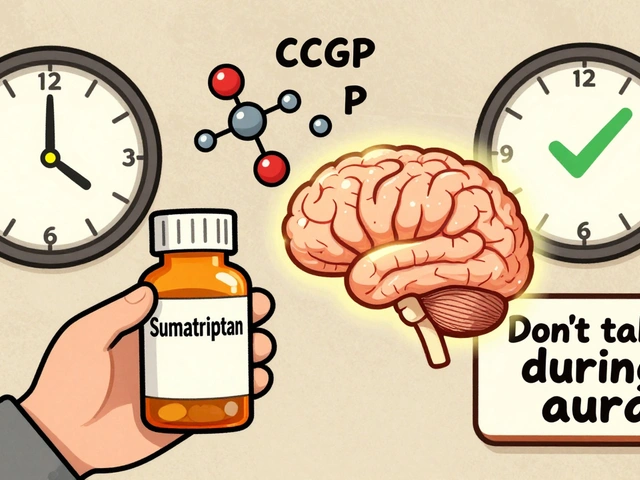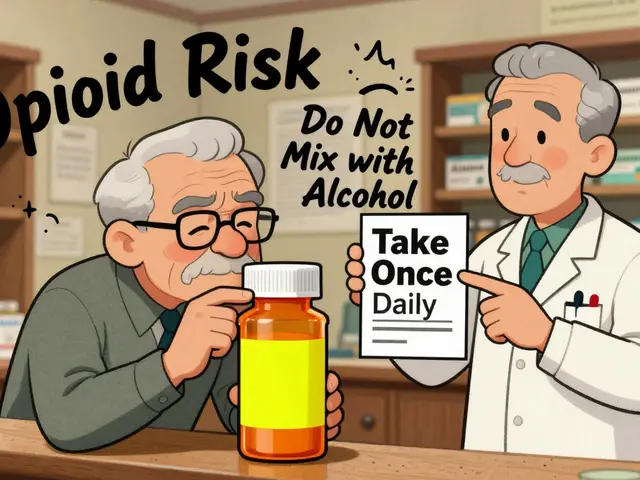Picture a medicine cabinet in a home where worry about seizures always sits quietly in the background. That’s Dilantin for thousands of families. Since its approval in the 1950s, Dilantin—also known by its generic name, phenytoin—has been a mainstay. It’s not some trendy new pill; it’s one of the oldest, steadiest tools in the epilepsy toolkit, a real workhorse when it comes to keeping those electrical storms in the brain at bay.
How Dilantin Works: The Science Made Simple
So, what’s happening when your doctor prescribes Dilantin? This isn’t just any anti-seizure drug. Dilantin’s job is to steady the flow of electrical signals in the brain. For anyone who’s experienced a seizure—or watched a loved one go through one—this is huge. Phenytoin works by blocking certain electrical channels (specifically, sodium channels) that, when overactive, can send the brain into chaos. The result: a lowered chance of that dramatic, uncontrollable activity that causes convulsions, muscle jerks, and confusion.
It isn’t a one-size-fits-all. Dilantin comes in different forms—capsules, chewable tablets, and even liquid suspensions. There’s also an IV version for hospital emergencies. Its dosing depends on age, weight, and metabolic rate, which is why some people get blood tests pretty often just to check that the levels are where they should be. Weird fact: phenytoin blood levels are tricky to keep in the Goldilocks zone—not too high, not too low. Even small changes in dose or other medications can throw things off.
Dilantin isn’t just for epilepsy either. Sometimes, neurologists give it after a serious head injury to stop seizures before they start. Rarely, it’s used to help with a type of irregular heartbeat—even though that’s much less common these days. But its main gig is still epilepsy, especially types called tonic-clonic and partial seizures. Kids, adults, even folks in their 70s—Dilantin has seen them all
Here’s something most don’t realize: genes matter. Some people’s bodies break down Dilantin slower because of genetic variations in liver enzymes. That can make levels shoot up, increasing the risk of side effects. Doctors are getting better at genetic testing now, so if you’ve ever wondered why your friend can breeze through on a high dose while you can’t—blame your DNA.
According to the CDC, about 3.4 million Americans have active epilepsy; Dilantin remains one of the most frequently prescribed oral medications in both pediatric and adult neurology clinics. Around the world, phenytoin’s familiar, reliable presence means it’s on the World Health Organization’s List of Essential Medicines. Not every drug makes that list, which speaks to its status as a must-have in hospitals everywhere, from New York to rural India.
Side Effects: What to Watch for and What You Can Do
No medication’s perfect—and Dilantin’s definitely in that club. If you’ve taken it or know someone who has, you might have heard about side effects like swollen gums, clumsiness, or even mood changes. The trick is knowing what to expect and when to call the doctor.
Here’s a quick rundown of common problems: some people get puffy gums (the dental term is gingival hyperplasia), which dentists can spot quickly. There’s also a shaky walk or slurred speech when levels get too high. Skin rashes? Yes, and very rarely, these can get serious. If you see a rash that spreads or blisters, that’s an emergency—because in rare cases, it’s a sign of a severe reaction called Stevens-Johnson syndrome.
Hands-down, the biggest tip I can offer? Brush and floss like you mean it. Daily dental care helps cut down on gum issues, and regular dentist visits are musts—I learned that the hard way thanks to a missed appointment and a stern hygienist. My son, Tobias, hated brushing as a kid, but after one rough bout of sore gums, he’s first in line for the toothpaste every morning. Trust me, a little prevention saves a lot of pain later.
Phenytoin can also mess with vitamin D absorption, which isn’t something people often think about. Over years, this can thin your bones—a real headache if you’re already prone to fractures or have a family history of osteoporosis. A good, regular check-up with your doctor can help spot this early. Sometimes, adding a vitamin D supplement or switching medications solves it.
Other side effects can include sleepiness, confusion, or even a sense of irritability. Some parents worry that their kids might act out, but the reality is that side effects can be pretty individual. For rare but serious mood changes or thoughts of self-harm, call your doctor fast. Safety always comes first, and these aren’t the kind of things you ignore until your next appointment.
Interestingly, Dilantin isn’t a big liver troublemaker, but because it’s broken down by the liver, people with liver disease need close monitoring. Elderly folks or people taking other medicines that depend on the same liver enzymes may need lower doses or more frequent checkups.
| Side Effect | How Common? | Tips to Manage |
|---|---|---|
| Gum swelling | Up to 20% | Good dental care, regular checks |
| Drowsiness | 5-10% | Take at night, adjust dose if needed |
| Unsteady walk | 5-15% | Check blood levels, watch dose |
| Skin rash | Less than 5% | Stop drug and see doctor quickly |
| Bone thinning | Rare, long-term | Vitamin D, regular bone scans |

Daily Life on Dilantin: Tips, Food Rules, and Monitoring
The everyday stuff with Dilantin is full of little tricks that can make life easier. Start with the obvious: set phone reminders or use a pill organizer. Despite my best intentions, I still hear “Did you take your pill?” echoing from the other room courtesy of Eleanor. Skipping even one dose can lead to breakthrough seizures, which nobody wants. Be as close to clockwork as you can—same time, every day, with or without food, though some people find it gentler with a snack.
Here’s a thing most folks overlook—food and drug interactions. Dilantin’s a finicky drug, and a bunch of other meds, including some antibiotics, antifungals, and even over-the-counter antacids, can mess with its blood levels. If you change anything in your medicine cabinet, let your doctor or pharmacist know. Even herbal supplements, especially things like St. John’s Wort, can mess with how Dilantin works.
Alcohol is a big no-no or, at the very least, something to talk over with your doctor. A single drink might not be a disaster, but heavy drinking can spike or drop Dilantin levels—leaving you at risk of either toxicity or a return of seizures. Caffeine, on the other hand, doesn’t usually mix directly with phenytoin, but missing sleep and dehydration can sneakily lower your seizure threshold. Staying hydrated and getting enough rest are under-rated, but completely game-changing tips for anyone living with epilepsy.
Regular blood monitoring isn’t busywork—it’s vital. Blood level checks catch problems before they start. Low albumin, pregnancy, liver changes, or starting a new medication can all mean you need a dose tweak. If you (or your child) get sick and can’t keep pills down, call your doctor sooner rather than later. Missing doses for even a day or two can result in return of symptoms.
Let’s talk about kids for a second. Tobias recently pointed out that his classmates never have to track their medicine times or get blood drawn. It can be a drag, but honest conversations about why this matters make a difference. Sharing real stories from others or even having a reward system for remembering daily pills can help younger kids stick with their regimen. If you’re a parent, practice what you preach—a visible pill chart’s nothing to be ashamed of.
Drug choices shift as you grow older, have babies, or take on new health problems. For women planning pregnancy, Dilantin brings special challenges: it can reduce the effectiveness of birth control and carries a risk of birth defects. There’s a balancing act between controlling seizures and protecting a new baby. If you’re thinking of growing your family, see your neurologist early—pregnancy usually means fine-tuning, and sometimes switching, your meds.
Long-Term Considerations: Safety, Switching, and What the Future Holds
After months or years on Dilantin, most people want to know: will I ever be able to stop? It’s a good question, but it comes with a big ‘it depends.’ If you’ve been seizure-free for a long time—and there’s no brain damage or active abnormality on an EEG—some neurologists will consider slowly tapering the dose. It’s never cold turkey. Abrupt stopping equals a high risk of sudden seizures, which is a dangerous game.
For those who need to be on phenytoin indefinitely, long-term monitoring is part of the deal. That usually means an annual bone density scan and more regular bloodwork, especially if anything else changes (new meds, illness, or surgery). Don’t forget: Dilantin can interact with cholesterol meds, blood thinners like warfarin, and drugs for heart rhythm, so your medication list should be reviewed at each doctor visit—no matter how boring or repetitive it seems.
Sometimes, new side effects or changes in your health push a switch to another anti-seizure med. The choices have exploded in recent years, with newer drugs that have fewer interactions and often lighter side-effects. These aren’t always better for every person—some still respond best to Dilantin, or can’t afford newer options (insurance and cost are serious real-life obstacles). But it’s nice to have a Plan B, C, or even D if needed.
One cool detail: phenytoin is the only drug in its class used in some rare autoimmune seizures (where the body’s immune system attacks the brain). That’s not most people, but it shows how versatile this classic drug can be. Its place in first-aid kits for prolonged seizures, especially in ERs and ambulances, is secure thanks to its fast-acting IV version.
Researchers haven’t given up on Dilantin, either. There are ongoing studies—yes, in 2025—testing phenytoin’s ability to protect nerve cells after traumatic brain or spinal cord injuries. So, while newer anti-seizure meds grab headlines, this old-timer keeps proving its worth in real-life emergencies and research labs alike.
If you stick with Dilantin, let your pharmacist and doctors know you’re on it. Who you trust with your health history matters—a missed drug interaction or wrong dose can undo months of good seizure control in a flash. Keep a medication list in your phone, and if someone asks about allergies, list phenytoin as well.
The world hasn’t solved epilepsy, but with reliable meds like Dilantin, the focus shifts from constant worry to living a real, full life. Whether you’re just starting or you’ve been on phenytoin for years, knowing the facts—good and bad—makes the path smoother for you and everyone around you.










Keeping a pill box handy makes Dilantin routine a breeze.
One practical habit is to sync your medication time with a daily activity you already do, like brushing your teeth. That way you’re less likely to forget a dose when life gets hectic. Also, setting a recurring alarm on your phone can serve as a reliable backup. If you ever switch pharmacies, double‑check that they’ve updated your medication profile, because a simple clerical error could throw off your blood‑level monitoring.
For anyone juggling school or work, a visual tracker on the fridge can be a game‑changer. Draw a simple grid with days across the top and “Dilantin” down the side, then check off each pill as you take it. It gives you instant feedback and a tiny sense of accomplishment. And don’t forget to keep a spare set of meds in a different bag in case you forget the main bottle at home.
Honestly, if you think a simple reminder is enough, you’re selling yourself short – Dilantin isn’t a casual over‑the‑counter vitamin. 🤨
People treat it like a nuisance, but the side‑effects can be brutal if you’re not vigilant. Remember, gum swelling isn’t just an “oops” it’s a sign your dosage might be off, and you owe it to yourself to see a dentist before it spirals.
Don’t let anyone convince you that cutting corners on blood tests is fine – that’s a slippery slope.
When contemplating the long‑term management of phenytoin therapy, it is imperative to adopt an interdisciplinary approach that incorporates pharmacokinetic monitoring, patient education, and risk mitigation strategies.
First, the serum concentration of phenytoin should be measured at steady state, typically after 7–10 days of dose stabilization, to ensure levels remain within the therapeutic window of 10–20 µg/mL.
Second, clinicians must be cognizant of the drug's nonlinear metabolism; small dose adjustments can result in disproportionate changes in plasma concentrations due to saturation of hepatic enzymes.
Third, genetic polymorphisms, particularly in CYP2C9 and CYP2C19, can profoundly influence clearance rates, necessitating genotype‑guided dosing in select populations.
Fourth, concomitant medications such as carbamazepine, phenobarbital, and certain antibiotics can induce hepatic microsomal enzymes, thereby lowering phenytoin levels and precipitating breakthrough seizures.
Fifth, inhibitors like cimetidine or oral contraceptives can elevate phenytoin concentrations, increasing the risk of neurotoxicity, gingival hyperplasia, and ataxia.
Sixth, regular dental examinations are not merely advisable but essential, given the high incidence of gingival overgrowth observed in up to 20% of patients on chronic therapy.
Seventh, bone health should be monitored through periodic DEXA scans, as long‑term phenytoin use has been associated with decreased vitamin D activation and subsequent osteopenia.
Eighth, clinicians should assess for signs of hypersensitivity reactions, including maculopapular rash or, in rare cases, Stevens‑Johnson syndrome, which mandates immediate discontinuation of the drug.
Ninth, patient adherence can be reinforced by integrating electronic medication reminders and caregiver involvement, especially in pediatric cohorts where dosing schedules are more complex.
Tenth, during pregnancy, teratogenic risk assessment must be balanced against seizure control, often requiring dose adjustment and close monitoring of fetal development.
Eleventh, in the event of therapeutic failure or intolerable adverse effects, transitioning to newer antiepileptic agents such as levetiracetam or lamotrigine should be considered, factoring in cost, insurance coverage, and individual pharmacodynamic profiles.
Twelfth, the emergency use of IV phenytoin for status epilepticus remains a cornerstone of acute care, yet infusion rates must be meticulously calibrated to avoid hypotension and cardiac arrhythmias.
Thirteenth, ongoing research into neuroprotective properties of phenytoin suggests potential off‑label applications in traumatic brain injury, but such use remains investigational.
Fourteenth, comprehensive medication reconciliation at each clinical encounter safeguards against inadvertent drug interactions, a critical component of patient safety.
Finally, fostering an open dialogue with patients about the benefits and drawbacks of long‑term phenytoin therapy empowers them to make informed decisions, ultimately improving adherence and clinical outcomes.
Great overview; the emphasis on periodic serum level checks is especially pertinent.